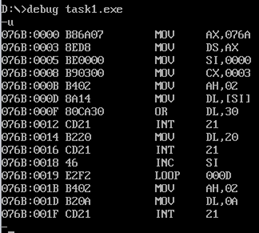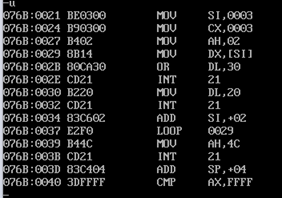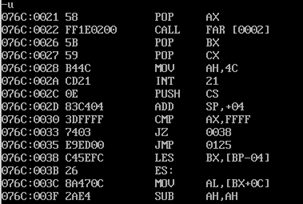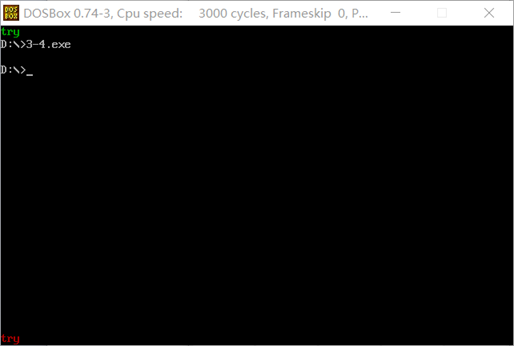1. Experimental Tasks
1 Write this part:
Give the program task1.asm source code, and run a screenshot
1 assume cs:code, ds:data 2 3 data segment 4 x db 1, 9, 3 5 len1 equ $ - x 6 7 y dw 1, 9, 3 8 len2 equ $ - y 9 data ends 10 11 code segment 12 start: 13 mov ax, data 14 mov ds, ax 15 16 mov si, offset x 17 mov cx, len1 18 mov ah, 2 19 s1:mov dl, [si] 20 or dl, 30h 21 int 21h 22 23 mov dl, ' ' 24 int 21h 25 26 inc si 27 loop s1 28 29 mov ah, 2 30 mov dl, 0ah 31 int 21h 32 33 mov si, offset y 34 mov cx, len2/2 35 mov ah, 2 36 s2:mov dx, [si] 37 or dl, 30h 38 int 21h 39 40 mov dl, ' ' 41 int 21h 42 43 add si, 2 44 loop s2 45 46 mov ah, 4ch 47 int 21h 48 code ends 49 end start

Answer Questions 1
(1) line27, the assembly instruction loop s1 jumps according to the amount of displacement. Through debug disassembly, look at its machine code and analyze how much displacement it jumps? (Displacement values are answered in decimal numbers) From the perspective of the CPU, how to calculate the offset address of the instruction following the jump label s1.
Displacement: -14
F2 is converted to 10-14 by subtracting the offset address 001B of loop s1 from the offset address 000D of mov dl [si]
Answer Questions 2
(2) line44, the assembly instruction loop s2 jumps according to the amount of displacement. Through debug disassembly, look at its machine code and analyze how much displacement it jumps? (Displacement values are answered in decimal numbers) From the perspective of the CPU, how to calculate the offset address of the instruction following the jump label s2.
Displacement: -14
F2 is converted to 10-14 using offset address 0029 of mov dl [si] minus offset address 0037 of loop s2
Question 3
(3) Disassembly screenshots of debugging observations in debug when the above analysis is attached


2. Experimental Task 2
Write this section:
Give program task2.asm source code
1 assume cs:code, ds:data 2 3 data segment 4 dw 200h, 0h, 230h, 0h 5 data ends 6 7 stack segment 8 db 16 dup(0) 9 stack ends 10 11 code segment 12 start: 13 mov ax, data 14 mov ds, ax 15 16 mov word ptr ds:[0], offset s1 17 mov word ptr ds:[2], offset s2 18 mov ds:[4], cs 19 20 mov ax, stack 21 mov ss, ax 22 mov sp, 16 23 24 call word ptr ds:[0] 25 s1: pop ax 26 27 call dword ptr ds:[2] 28 s2: pop bx 29 pop cx 30 31 mov ah, 4ch 32 int 21h 33 code ends 34 end start
Given analysis, debugging, validation, register (ax) =? (bx) =? (cx) =? Attach a screenshot of the debug results interface.
(1) According to the jump principle of call instruction, theoretical analysis is made first. Register (ax) =? Register (bx) =? Register (cx) = before program execution (line31)?
Theoretical analysis: ax should be the offset address for the s1 tag, bx should be the offset address for the s2 tag, and cx should be the segment address
(2) Assemble and link the source program to get the executable task2.exe. Debug with debug to observe and verify whether the results of debugging are consistent with the results of theoretical analysis.


Consistent with analysis results
3. Experimental Task 3
Write this section:
Gives a screenshot of the program source task3.asm run test
1 assume cs:code,ds:data 2 3 data segment 4 x db 99, 72, 85, 63, 89, 97, 55 5 len equ $- x 6 data ends 7 8 code segment 9 start: 10 mov ax,data 11 mov ds,ax 12 mov si,0 13 mov cx,6 14 s: 15 mov ax,offset printNumber 16 call ax 17 mov ax,offset printSpace 18 call ax 19 loop s 20 mov ah,4ch 21 int 21h 22 23 printNumber: 24 mov ah,0 25 mov al,[si] 26 inc si 27 mov bl,10 28 div bl 29 or al,30h 30 mov bl,al 31 or ah,30h 32 mov bh,ah 33 mov ah,2 34 mov dl,bl 35 int 21h 36 mov ah,2 37 mov dl,bh 38 int 21h 39 ret 40 41 42 printSpace: 43 mov bl,' ' 44 mov ah,2 45 mov dl,bl 46 int 21h 47 ret 48 49 50 code ends 51 end start

4. Experimental Task 4
Write this section:
Gives a screenshot of the program source task4.asm run test
1 assume cs:code,ds:data 2 3 data segment 4 str db 'try' 5 len equ $ - str 6 data ends 7 8 code segment 9 start: 10 mov ax,data 11 mov ds,ax 12 mov ax,0b800h 13 mov es,ax 14 mov si,0 15 mov di,0 16 mov bl,2 17 mov ax,offset printStr 18 call ax 19 20 mov ax,0b8f0h 21 mov es,ax 22 mov si,0 23 mov di,0 24 mov bl,4 25 mov ax,offset printStr 26 call ax 27 28 29 mov ah, 4ch 30 int 21h 31 32 printStr: 33 mov cx,3 34 s: 35 mov bh,[si] 36 mov es:[di],bh 37 inc di 38 mov es:[di],bl 39 inc si 40 inc di 41 loop s 42 ret 43 44 code ends 45 end start

5. Experimental Task 5
Write this section:
Gives a screenshot of the program source task5.asm run test
1 assume cs:code,ds:data 2 3 data segment 4 stu_no db '20192308063' 5 len = $ - stu_no 6 data ends 7 8 code segment 9 start: 10 mov ax,data 11 mov ds,ax 12 mov ax,0b8f0h 13 mov es,ax 14 mov si,0 15 mov di,0 16 mov cx,35 17 s: 18 mov byte ptr es:[di],'-' 19 inc di 20 mov byte ptr es:[di],00010111b 21 inc di 22 loop s 23 24 mov cx,11 25 s1: 26 mov bh,[si] 27 inc si 28 mov es:[di],bh 29 inc di 30 mov byte ptr es:[di],00010111b 31 inc di 32 loop s1 33 34 mov cx,34 35 s2: 36 mov byte ptr es:[di],'-' 37 inc di 38 mov byte ptr es:[di],00010111b 39 inc di 40 loop s2 41 42 mov ah, 4ch 43 int 21h 44 45 46 code ends 47 end start

Experimental summary
In this experiment, I further understand the principle of transfer instructions by using them. Another benefit of this experiment is that you have a better understanding of the screen output of 8086 cpu. Beginning in memory space b8000 is the control screen output. Each word represents a character on the screen. The first byte represents the character assic code value, and the last byte controls the foreground, background, highlight, and flicker information of the character.